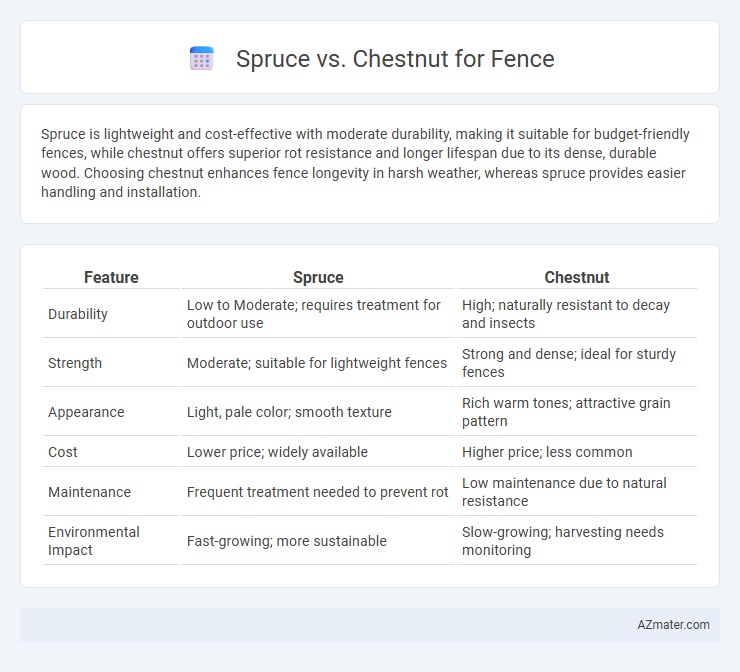Spruce is lightweight and cost-effective with moderate durability, making it suitable for budget-friendly fences, while chestnut offers superior rot resistance and longer lifespan due to its dense, durable wood. Choosing chestnut enhances fence longevity in harsh weather, whereas spruce provides easier handling and installation.
Table of Comparison
| Feature | Spruce | Chestnut |
|---|---|---|
| Durability | Low to Moderate; requires treatment for outdoor use | High; naturally resistant to decay and insects |
| Strength | Moderate; suitable for lightweight fences | Strong and dense; ideal for sturdy fences |
| Appearance | Light, pale color; smooth texture | Rich warm tones; attractive grain pattern |
| Cost | Lower price; widely available | Higher price; less common |
| Maintenance | Frequent treatment needed to prevent rot | Low maintenance due to natural resistance |
| Environmental Impact | Fast-growing; more sustainable | Slow-growing; harvesting needs monitoring |
Introduction to Spruce and Chestnut Wood
Spruce wood is known for its light weight, straight grain, and pale color, making it an economical choice for fences with moderate durability in outdoor conditions. Chestnut wood offers exceptional rot resistance and a rich, warm tone, prized for longevity and aesthetic appeal in fencing applications. Both woods provide unique benefits, with spruce excelling in cost-effectiveness and chestnut valued for natural durability and strength.
Key Differences Between Spruce and Chestnut
Spruce wood is lightweight, has a fine, straight grain, and offers moderate durability, making it suitable for budget-friendly fence projects requiring easy handling. Chestnut wood is denser, highly resistant to decay, and contains natural tannins that enhance longevity, ideal for long-lasting, weather-resistant fencing. While spruce requires protective treatments to withstand outdoor conditions, chestnut's inherent durability reduces maintenance needs and extends fence lifespan significantly.
Durability and Lifespan Comparison
Spruce fences typically offer moderate durability with a lifespan of 10 to 15 years when properly treated and maintained, but are more susceptible to rot and insect damage compared to chestnut. Chestnut wood is renowned for its exceptional natural resistance to decay and pests, often lasting 25 years or more without requiring extensive chemical treatments. The superior durability and longer lifespan of chestnut make it a more cost-effective and sustainable choice for long-term fencing solutions.
Resistance to Weather and Pests
Spruce fences offer moderate resistance to weather but are more vulnerable to pests and decay compared to chestnut. Chestnut wood, known for its high natural tannin content, provides superior resistance to both weather conditions and insect infestations, making it more durable for outdoor fencing. Choosing chestnut enhances longevity and reduces maintenance costs due to its robust defense against moisture, rot, and termite damage.
Maintenance Requirements
Spruce fences require regular sealing or staining to protect against moisture and prevent rot, typically needing treatment every 2-3 years to maintain durability. Chestnut fences naturally resist decay and insect damage, significantly reducing the frequency of maintenance and the need for chemical treatments. Choosing chestnut offers a longer-lasting, low-maintenance solution compared to spruce, especially in environments prone to moisture and pests.
Aesthetic Appeal and Grain Patterns
Spruce fences showcase a light, creamy color with subtle grain patterns that create a clean and modern aesthetic, ideal for minimalist or contemporary outdoor spaces. Chestnut features rich, warm brown tones complemented by pronounced, swirling grain patterns that add character and a rustic charm to fence designs. The distinct texture and coloration of chestnut enhance visual interest, while spruce offers a more uniform and understated look suitable for versatile landscaping styles.
Environmental Impact and Sustainability
Spruce fences typically have a lower environmental impact due to faster growth rates, allowing more frequent harvesting without depleting resources, while chestnut offers exceptional durability, reducing the need for replacements. Chestnut wood is naturally resistant to decay and pests, minimizing chemical treatments that can harm ecosystems, in contrast to spruce, which may require additional preservatives. Choosing chestnut supports long-term sustainability by enhancing fence lifespan, whereas spruce represents a renewable option aligned with responsible forest management.
Cost and Availability
Spruce fences typically cost less than chestnut due to the faster growth rate and wider availability of spruce trees in North America and Europe, making spruce a budget-friendly option. Chestnut offers greater durability and rot resistance, which can reduce long-term maintenance costs, but its limited availability drives prices higher. Availability of spruce is widespread in lumberyards and home improvement stores, whereas chestnut is more niche and often sourced from specialty suppliers or reclaimed wood markets.
Best Applications for Spruce vs Chestnut Fences
Spruce fences are ideal for cost-effective, lightweight fencing projects suited to residential boundaries and garden enclosures due to their softwood nature and ease of installation. Chestnut fences offer superior durability and natural rot resistance, making them best for long-lasting, outdoor applications such as agricultural fencing and high-traffic perimeter barriers. The choice between spruce and chestnut depends on budget constraints and exposure to environmental elements, with chestnut preferred for weather-resistant and maintenance-free fencing solutions.
Which Wood Is Better for Your Fence?
Spruce and chestnut differ significantly in durability and resistance, with chestnut offering superior natural rot resistance and longevity for fencing compared to spruce's softer, less durable nature. Chestnut's hardness and weather resistance make it a better choice for long-term, low-maintenance fencing, while spruce is more affordable but requires regular treatment to withstand outdoor conditions. Selecting chestnut ensures enhanced strength and durability, making it the optimal wood for fences exposed to harsh weather and heavy wear.

Infographic: Spruce vs Chestnut for Fence
 azmater.com
azmater.com